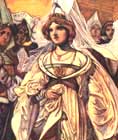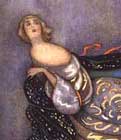
Cinderella:
345 Variants
by Marian
Roalfe Cox
SurLaLune's
Cinderella Area
SurLaLune Fairy Tales Main Page
63
Kristensen, E. T., Unpublished Collection. (Narrated by Inger Katrine Pedersdatter, on Hestbaek Mark, Jutland.)
"PISH-I-ASKE"
(Whip-in-the-Ashes).1
ABSTRACT
Ill-treated heroine (by step-mother)---Hearth abode-Strange man aid--Heroine promises to give her first, second, and third children to strange man in exchange for Magic dresses--Meeting- place (church) flight--Lost shoe--Shoe marriage test--Mutilated feet of stocking--Animal witness (crow)-- Happy marriage--Strange man would claim heroine's children; she repeats words taught her by beggar, who has overheard them; strange man flies into flints-- Beggar rewarded.
TABULATION
(1) Man with one daughter marries widow with one daughter. Man's daughter is the more beautiful, and is made to sit always whipping in the ashes.-- (2) On Sunday heroine asks stepsister to let her wear some of her old clothes to go to church. "No, you Whip-in-the-Ashes!" Heroine returns to the kitchen crying. A strange man enters by back door, and asks why she cries. "Because I wanted to borrow some of my stepsister's old clothes to go to church in, and was denied "Will you promise me your first son if I give you clothes to go to church in?" "Yes, certainly; for I shall never have children. I must always sit in the ashes."-- (3) Instantly there is a handsome silk dress for her, besides stockings and shoes, and a carriage at the door. "Light before and mist behind! Nobody shall see where we are driving." She has been told that the moment the precentor leaves his pew to read the last prayer she must leave the church, hasten home, and change her dress before the others return. She does so, says "Light before", etc., and hurries home. She had sat in the family pew in church, and stepmother and stepsister had squeezed themselves back into the far corner. On their return they tell her of the beautiful lady. She says it cannot concern her to hear about her, since she may not go herself; and she a hips up the ashes so as to raise a dust.-- (4) Next Sunday the same thing happens; she promises her second son to the stranger, and gets same clothes and carriage.-- (5) Third Sunday she promises third son, and gets more beautiful clothes and golden shoes. King's son is at church, and follows her closely, treading off one of her shoes. He wants to speak to her, but she gets into carriage. The stranger is waiting for her, and says, "You may keep the dress; they will soon send for you. Take the one remaining shoe in your hand, and go away as you are." Prince asks all the congregation whose the shoe is. He will wed whomsoever it fits.-- (6) Among the girls who try is heroine's stepsister, who cuts a bit off the toe and the heel of her stocking, and forces the shoe on. A crow in tree says, "Cut from heel, cut from toe! The golden shoe was trodden off the little girl who sits at home whipping the ashes." "What does crow say?" asks prince. "Pshaw! what's a crow's cawing?" says stepmother. Crow repeats song more loudly a second and a third time. Prince questions step-mother, who is at last obliged to admit that she has another girl at home.-- (7) Heroine is sent for, and appears, magnificently dressed, and carrying the shoe in her hand. Prince recognises her; marries her.-- (8) Heroine is unhappy before her child is born. Prince tries to comfort her. She bears a son, and the strange man appears;2 but obtaining her promise to give heed during the night to [what is heard] outside the window, he allows her to keep first child till she has others. When her second son is born the same thing happens. Before the birth of the third child she is very sorrowful.-- (9) A tired old beggar resting on a hill hears a voice underground crying, "Ha, ha! ha, ha! Faldera! To-night I am to get the queen's three children. I'll roast one tonight I'll salt the second; the third I'll hang p in the smoke. If the queen were as knowing as I am she would just say to me: 'You red bull without horns, none of my children shall you get. I am the one who has suffered for them.' If site were to say that thrice to me I should get into a towering passion and fly into flints!"3 Away goes the beggar, and endeavours to see queen, but is denied admission. At last he tells watchman that she might be able to save more than one soul. When king and queen hear this they have beggar admitted, and he tells his story. King and queen ate greatly comforted, and give him food and wine to his heart's content.-- (10) At night a voice is heard outside the window demanding the children. Thrice the queen repeats the magic words, and the stranger flies into flints. King and queen live happy ever after. Beggar has never occasion to beg again.
NOTES
1: In the large manors it was the
duty of the lowest of all the servants, who was called "Whipper-of-the-Ashes",
to remove all the ashes and every kind of refuse from the dunghill in
a small two-wheeled cart. Therefore Cinderella in the Danish tales is
nicknamed "Whipper-of-the-Ashes", as the meanest of the mean.
"To whip" is now used figuratively in the sense of "to
stir, to puke".-- F.
Return to place in text.
2: The houses in Denmark are small
and low, and are all built on the same plan. The door is usually closed
at night, and there may be a loose dog in the yard. A benighted traveller
wishing to inquire his way would easily guess in which room the married
people sleep, and would tap at the window-panes to arouse them. In the
same way the demon comes to the window at night to demand the child--
F.
Return to place in text.
Note 46
(P. 292.) In this story (No. 63), as in No. 40, there is an element of "Rumpelstiltskin"; the heroine has promised her children in return for aid; but the mention of his name causes the destruction of the being to whom she is under obligation. So in the hero-tales, Nos. 320, 334, the helpful ox loses all power when the boy calls him by name. Sigfred hides his name from Fafni (C. P. B., i, 35). See Mr. Clodd's paper on "The Philosophy of Rumpelstiltskin" (F.-L. Journal, vii, 135 ff.), and add the following to the list of variants there cited:--Chodzko, Contes des Paysans et des Patres Slaves, pp. 341-47, "Kinkach Martinko"; Longman's Magazine, July 1889, p. 331, "Peerifool"; Zingerle, Kind. u. Hausm. aus Süd-Deutschland, pp. 278-80, "Kugerl"; Tirols Kind. u. Hausm., pp. 225-32, "Purzinigele."
Compare Nos. 288, 306, in which the heroine must remember the name of her benefactor.
[SurLaLune Note: Edward Clodd later published Tom
Tit Tot: An Essay on Savage Philosophy in Folk-Tale (1898) which expands
on his paper "The Philosophy of Rumpelstiltskin" mentioned in
this note.]
Return to place in text.
Cox, Marian Roalfe. Cinderella: Three Hundred and Forty-five Variants of Cinderella, Catskin, and Cap O' Rushes, abstracted and tabulated. London: David Nutt for the Folklore Society, 1893.
While the original text of this book is out of copyright, the special formatting and compilation available on SurLaLune Fairy Tales is copyrighted. Be aware that while the original content has been honored, page numbering, footnote numbering, redesigned charts, links, and other aspects are unique to this site's version of the text. Use at your own risk. For private and fair use educational purposes only.
©Heidi
Anne Heiner, SurLaLune Fairy Tales
E-mail: surlalune@aol.com
Page last updated February 1, 2006
www.surlalunefairytales.com










